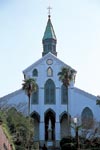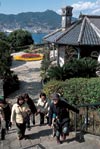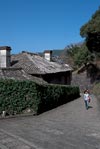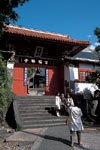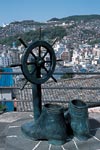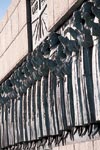|
|
 |
(1) |
Oura Church was constructed in 1864. It was designed by Père Furet, a French priest, and built by Japanese carpenters. |
|
|
|
 |
(2) |
The Former Glover Residence was designed by a British trader named Thomas Glover, and built by Japanese carpenters. Seen from above, the building resembles a four-leafed clover. |
|
|
|
 |
(3) (4) |
Koshi-byo Temple was built in 1893 to honor the ancient Chinese philosopher, Confucius. The colorfully painted temple has statues brought from China depicting Confucius and 72 of his followers. |
|
|
|
 |
(5) |
Streetcars are the best way to get around the city. You can buy a day pass. |
|
|
|
 |
(6)
|
Years ago, the entire sloped walkway passing through the old foreign settlement was called Oranda Zaka ("Holland Slope"). Today, the name refers only to the part north of the Confucian temple to the bottom of the slope to the northwest. The flagstones look even more beautiful in the rain. |
|
|
|
 |
(7) |
Modern buildings stand where the island of Dejima was once situated. Located on the site are the Dejima Museum of History and a 1/15-scale model of the island and its buildings. Work is progressing on reconstruction of the entire site at a different location, with completion scheduled for 2010. |
|
|
|
 |
(8) |
Sofuku-ji Temple was founded in 1629 by Chinese residents of Nagasaki, to pray for safety at sea. The main building, called Daiyu Hoden, and the Dai-ippo-mon Gate are National Treasures. |
|
|
|
 |
(9) |
Statuesque boots, representing those of Sakamoto Ryoma, a man whose efforts contributed greatly to the drive to modernize the country. He also established a trading company in Nagasaki. |
|
|
|
 |
(10) |
Christianity was banned in Japan at the end of the 1500s, and 26 believers were executed in Nagasaki. In 1950, Pope Pius XII declared the Site of Martyrdom of the 26 Saints of Japan to be an official place of pilgrimage for Roman Catholics. |
